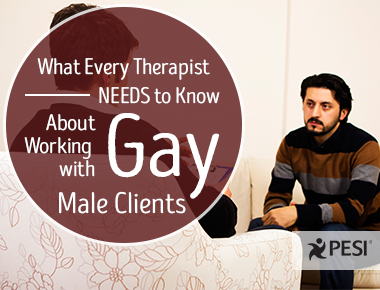What Every Therapist Needs to Know about Working with Gay Male Clients

As therapists, it is our responsibility to be educated about the people we see. Our waiting rooms do not discriminate, and it is very unlikely that any therapist will go through an entire career without opening the door to a gay male client.
Many clinicians wish they had more experience in working with gay men and may also have questions that they are too embarrassed to ask others, as if they should automatically have these answers. It is common to experience some uncertainty regarding nuances of gay male life. Increasing your awareness will help you feel more confident with clients, and they will feel a stronger bond with you as a result.
Topics that therapists wonder about while working with gay men:
Uncertainties regarding aspects of growing up gay.
Regardless of how comfortable your client appears as an adult, his growing up gay included some aspect of hiding and dissociation results in his holding himself back as an adult, perhaps without even being aware of this. Successful therapy takes this into account, even if the presenting problem is different from this theme.
Pressures relating to being absorbed in the gay male community.
The gay male subculture places stringent expectations on its members. The emphasis of beauty, youth, money, and friendships “in the scene” impact how your client will view himself in comparison to others. Working with him from the inside will help him feel self-pride.
Discussing sex with your client.
This is always challenging for non gay therapists! What to ask, how explicit to be, wondering if he feels awkward, or your feeling inexperienced in discussing sex puts more pressure on yourself. Accessing information and getting support is easier than you realize. All providers ought to educate themselves on discussing sex with everybody, especially gay clients. The best way for you to start is to clarify for yourself what your beliefs and biases may be.
Helping your client find balance in daily life.
Since your client was raised male, (even if he internally feels as though he falls short of the masculine ideal), expectations regarding family, career and success have been imposed on him. In order to fulfill these expectations, he likely has emphasized success without tending to internal needs that may seem obvious to you, but not him. Excelling doesn’t come without a cost. His most overlooked tools are the natural abilities he possesses internally, and with your guidance, he will feel rejuvenated by your guiding and teaching him to practice mindfulness techniques.
Building a therapeutic alliance.
The importance of your relationship is a necessary part of the psychotherapy process. Your genuine respect of him compensates for earlier experiences of non acceptance by others, especially authority figures. Appreciate that in this context, your role is more significant than either of you may have realized!
In my role as an educator, it is compelling when therapists are willing to admit that they don’t know everything they should about what it is to be gay or how to work with gay clients. It takes courage to admit this, especially in the new climate in which sexuality is front and center in national conversation.
In my new book, Mindfulness Tools for Gay Men in Therapy, each chapter offers questions for you as a clinician to assess your own acceptance, mindfulness exercises for internal strength designed specifically for gay men, as well as plentiful worksheets and exercises for you to administer that facilitate success in functioning on a mind-body level.
I often suggest that in the early stages of treating a gay client therapists complete the Positive Attributions Exercise. This exercise will help you clarify the type of defenses your client has honed over his lifetime and, more importantly, how to guide him toward updating the ways in which he navigates his life. As a result, the effects of treatment will be even more powerful.
Topic: Clinical Psychology and Psychiatry
Tags: LGBTQ | Mindfulness | Shame




